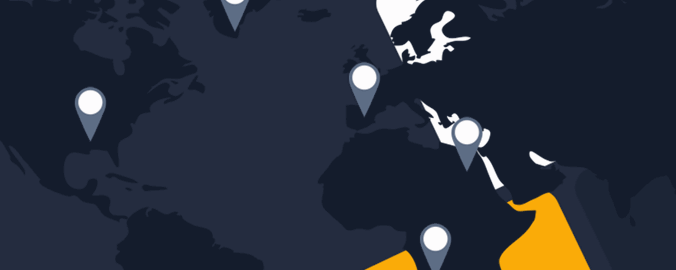
Area Guide to Brazil
From the Amazon basin in the north and west to the Brazilian Highlands in the southeast, the topography of Brazil is diverse. The Amazon River carries more water to the ocean than any other river system in the world. It is navigable for its entire 2,000 mile strip within Brazil. The river basin, housing the rain forest, receives more than eighty inches (about 200 cm) of rain per year.
The Brazilian highlands generally average less than 4,000 feet (1,220 meters) with the highest point in Brazil being Pico de Neblina at 9,888 feet (3,014 meters). The highest regions lie in the southeast and stoop down escarpments to the Atlantic coast. There is little seismic or volcanic activity due to Brazil's position near to the centre of the South American Plate.
Almost all of Brazil is humid and has either a tropical or subtropical climate. Brazil's rainy season occurs during the summer months while eastern Brazil suffers from regular periods of drought.
The land mass of Brazil encompasses so much of South America that it shares borders with all South American nations except Ecuador and Chile. Brazil is divided into 26 states and a Federal District. The capital city of Brazil is Brasilia, a carefully planned city built in the late 1950s in the Mato Grasso plateau.
Sao Paulo and Rio de Janeiro, two of the world's fifteen largest cities can be found in Brazil and they are located only about 250 miles (400 km) apart. Rio de Janeiro's status suffered when it was replaced by Brasilia as the capital in 1960, a position Rio de Janeiro had held since 1763. However, Rio de Janeiro is still the undisputed cultural capital of Brazil and is a major international transport hub. Sao Paulo is growing at an incredible rate. The population currently stands at around 22 million.
Portuguese colonization began in northeastern Brazil in 1500 after Pedro Alvarez Cabral's accidental landing, after which Portugal established plantations in Brazil and brought slaves there from Africa. In 1808 Portuguese royalty went to live in Rio de Janeiro after being ousted by Napoleon's invasion. In 1822, Brazil proclaimed its independence, while it remains the only Portuguese-speaking nation in South America.
In 1964 a military coup d'état gave Brazil a military government for more than twenty years and since 1989 Brazil has had a democratically elected civil leader.
Information Required When Travelling to Brazil
Visas:
Foreigners are allowed 3 month visas, or 180 days total per year in Brazil. If you want to apply for a permanent visa, one of the following conditions must be met:
You are married to a Brazilian. You have a child with a Brazilian. You invest 250.000 US dollar or Euro in Brazil. You have reached the age of retirement (50 years) with a pension.
There are various other visas required if you are to work in Brazil.
Vaccinations:
Hepatitis A, Diptheria, Yellow Fever, up-to-date Tetanus and Polio.
Time Zone:
Brazil is the 4 hours behind GMT time.
Electricity:
Most states use 127 volts but there is no real standard voltage in Brazil.
Weights and Measures:
Metric system.
Tel. Dialing Code:
00 + 55 + 0014 (Brasil Telecom)
0015 (Telefonica)
0021 (Embratel)
0023 (Intelig)
0031 (Telemar)
Tropical Beaches
Brazil boasts some 7,000 km of beautiful white sandy beaches and crystal blue sea, along with exotic vegetation and palm trees which continue to attract growing numbers of visitors each year.
Hot Summers and Mild Winters
Brazil’s climate is ideal for many people. Split into four distinct climates, it can offer something for all tastes while offering year-round sunshine, with average summer temperatures of 21°C.
The four climatic regions are; the Amazon Basin, the Brazilian Plateau, the coast of the Tropics and the southern states. The Amazon basin has no real dry season and Tropical temperatures are typically a humid 27-32 °C / 80-90 °F.
The Brazilian Plateau has a distinct wet season between October and April while the northeast of the region has a much lower average rainfall (in some places less than 750 mm / 30"). The Tropical east coast, which includes Rio de Janeiro, has a hot Tropical climate making it very popular as a tourist destination. In turn, the southern states have a warm temperate climate with an average of 8-9 hours of sunshine a day in summer.
Portuguese, Spanish English and French Widely Spoken
Brazil is a very cosmopolitan country with investors from all over the world opting for property investment in the area. Language barriers are rarely a problem as English is widely spoken in most situations.
One bonus for many buyers is that there is a good chance of their own language being spoken while French, Spanish and English are all spoken widely in addition to native Portuguese.
Sightseeing
Brazil boasts a wealth of interesting sights for visitors to enjoy while much sightseeing is based upon the stunning natural beauty to be found here. The Amazon Rain Forest hosts thousands of rare species, flora and fauna, indigenous tribes as well as sheer wilderness. Dramatic water falls can be enjoyed at Iguaza and the Pantanal Swamps offer a plethora of wildlife and plant species to be admired by the adventurous visitor.
For a less intrepid experience, the famous Copacabana Beach, stretching three miles in front of the densely populated city of Rio de Janeiro is a must and offers an exciting and vibrant atmosphere with a lively street culture.
Accessibility
As the country is becoming increasingly popular as a place to visit, do business or purchase property in, direct charter flights to Brazil are now available from the UK (Heathrow airport) to Salvador for around £180 return.
Brazil proves to be a truly viable holiday destination. It is a promising buy-to-let investment location by virtue of its world-class transport infrastructures that are more than ready to cater for an increased influx of tourists.
Brazilian Cuisine
Brazil’s population consists of an interesting mix of Portuguese, African, Italian, German, Syrian, Lebanese and Asian origins, creating a rich cultural heritage. This ethnic mix is responsible for the great diversity to be found in the cooking styles of Brazil.
In Brazil, food varies from area to area:
The North
This area covers the rain forests and tributaries of the Amazon River. Culturally, the Amazon basin is heavily populated by native Indians or people of mixed Indian and Portuguese ancestry, living on a diet of fish, root vegetables such as manioc, yams, and peanuts, plus palm or tropical fruits. The cuisine of this region is therefore heavily Indian influenced. One popular dish is Caruru do Para, a one-pot meal of dried shrimps, okra, onion, tomato and coriander.
The Northeast
Inland, the north east region is semi-arid and used for cattle rearing. Here foods typically include ingredients like dried meat, rice, beans, goat, manioc and corn meal.
On the fertile coastal plain, Brazil’s important sugar cane and cacao growing area is located. The spectacular beaches to be found here are responsible for Brazil's fastest growing tourist region. Within the State of Bahia the predominant cuisine is Afro-Bahian, which evolved from plantation cooks improvising on African, Indian, and traditional Portuguese dishes while using locally available ingredients.
On the other coastal plains the influence on food is less African while seafood, shellfish, and tropical fruits remain menu staples.
The Central West
This region comprises open, dry savanna's or prairies with woodlands in the north. The famous Pantanal, one of the finest game and fishing regions on Earth, is also located within this region.
Fish from the main rivers as well as beef and pork from the vast ranches of the region dominate the menu. In addition, agricultural crops of soybean, rice, corn and manioc are commonly eaten.
The Southeast
This is the industrial area of Brazil and it is home to the several distinctive styles of cooking.
In Minas the regional dishes include a lot of corn, pork, beans, and local soft cheeses. Around Rio and Sao Paulo a simmered bean and meat dish of Bahian origin, feijoada completa, is popular especially in restaurants for lunch. Another popular dish is arroz-feijao (rice and beans). Traditionally, black beans are prepared in Rio, red or white beans in Sao Paulo, and either black or red in Minas Gerais.
In Sao Paulo, the influence of European and North African immigrants is strong in the region's cuisine. The majority of these origins are Italian, Portuguese, Arab and Spanish.
The South
This is home to the national cuisine of the Gaucho (cowboy), dishes made with sun or salt dried meats and churrasco, a meal of wood fire grilled fresh meats.
The immigrant homesteaders developed a wheat based diet. They were agricultural people who worked the land and introduced wine, leafy vegetables, and dairy products to the Brazilian diet. When potatoes were not available they improvised and discovered the native sweet manioc could be cooked and served in the same way as potatoes.
Typical Brazilian Foods
Beans (feijao) - Beans appear on the table daily in a great variety of forms and colors. Some people consider the black bean (feijao preto) to be the preferred national bean. It is not uncommon, however, to find dried red beans, white, brown, pink or black-eyed beans, as well as chick peas in the local markets.
Coconut - An important ingredient throughout the country, coconut is used in soups, cocktails, poultry, fish, and shellfish recipes, as well as in sweet dishes. Coconut is used in various forms: unripe green coconuts (cuco verde); ripe yellow or brown coconuts (cuco amarelo); the soft, almost buttery textured meat from green coconuts (cuco de agua); or grated (cuco ralado).
Dendi oil (azeite de dendi) - A heavy tropical oil extracted from the African palm of Northern Brazil. This is one of the basic ingredients in Bahian or Afro-Brazilian cuisine and it adds a rich flavour and bright orange colour to foods. There is no equivalent substitute.
Dried, salted cod (bacalhau) - Introduced by the Portuguese, bacalhau is a common appetizer, soup ingredient, main course and even a savory pudding. The fish is soaked in cold water in large pieces with the skin and bone removed for three to four hours, changing the water every hour.
Dried shrimp (camarao seco)- In various sizes, dried shrimps are used in many dishes from the northern regions of the country. Before cooking, the shrimps are covered with cold water and soaked overnight (without refreshing with new water) and the water is discarded before they are used.
Lemon - Most recipes in Brazil contain lemon. In Brazil the lemon is quite green, small and tart, and is more similar to limes as we know them.
Rice, Brazilian style (arroz brasileiro or arroz simples) - Long-grained, fluffy rice briefly sauteed in garlic and oil before adding boiling water. In addition to garlic, some Brazilian cooks use small amounts of onion, diced tomato, or sliced black olives for extra flavour.
Toasted Manioc Meal (farofa or farinha de mandioca) - Manioc flour lightly is sauteed in butter until it resembles buttered bread crumbs and other ingredients are added.
Healthcare in Brazil
Comprehensive medical and travel insurance is strongly recommended before travelling to Brazil. Many Brazilians prefer to take out a private health insurance plan and there are plenty available, including BUPA.
You should contact your GP for advice on recommended vaccinations which depend upon which areas of Brazil you intend to visit. Malaria is a risk in some northern parts of Brazil and you are advised to minimise exposure to mosquito bites by covering up and using repellents. Commonly recommended vaccinations for Brazil:
Hepatitis A
Recommended for everyone
Yellow Fever
Recommended for all areas in the states of Acre, Amapa, Amazones, Goias, Maranhao, Mato Grosso, Mato Grosso do Sol, Minas Gerais, Para, Rondonia, Roraima, and Tocantins, and parts of the states of Bahia, Parana, Piaui, Rio Grande do Sul, and Sao Paulo.
Required if you are arriving from a yellow-fever infected area of Africa or the Americas.
Hepatitis B
For those who may have intimate contact with local residents, especially when visiting for more than 6 months
Rabies
For those who may have direct contact with animals and may not have access to medical care
Routine Vaccinations
All travelers should be up-to-date on tetanus-diphtheria, measles-mumps-rubella, polio, and chicken pox vaccinations
Tap water is heavily treated in most cities giving it a rather chemical taste but it is safe to drink, provided it has been passed through a charcoal filter system. It is best to check with the hotel or restaurant management before drinking tap water. Tap water in remote areas can be unsafe even if filtered so you are advised to stick to bottled mineral water, which is widely available.
Medical/dental care in Brazil is generally considered to be good, especially in capital cities. The INSS (National Institute for Social Security) is the national social security system and all workers and their employers make compulsory contributions to the system, giving them the right to medical services and eventually a pension.
The healthcare service varies in efficiency according to city and district and you will hear reports of long queues and other stories of prompt treatment. Municipal hospitals are widely available, which provide free treatment including emergency services to everyone.
With the more stable economy, medical plans have improved, and private pension plans are now available. One major difference when comparing to other healthcare systems is that you do not always have to go through your GP to receive a specialist consultation.
Driving In Brazil
If you enter Brazil in a private vehicle, you must bring your driving license, all original registration and ownership documents (including logbook) as well as evidence of insurance valid in Brazil. If you have hired a car, make sure you have the original contract document which should state that the vehicle can be brought into Brazil. Border officials will impound your vehicle if they are not satisfied that you own it or have permission to use it in Brazil.
Since 1st January 2005, tolls have been charged on motorways and main roads outside town and these are payable in Real. The rate for cars is currently the equivalent of 5 Euros for a one week vignette/12 Euros for one month. Rates are much higher for freight vehicles and coaches with eight or more passengers. Vignettes can be purchased at ports and border points, and are also available from post offices and DZI bank offices. Fines are charged for those without the appropriate vignette.
The speed limits in Brazil are 60 km/h in populated areas, 80 km/h outside populated areas and 120 km/h on motorways, while spot fines are charged, even for minor violations. Petrol stations are to be found on average every 30 to 50 km. Brazilians drive on the right-hand side of the road, so full beam stickers should be stuck on any UK vehicle prior to departure. It is also advisable to carry an emergency triangle in your car.
If your vehicle is stolen while you are in Brazil, you will be considered liable for import duty and related taxes. If you cannot pay, you will have to sign a declaration upon departure, confirming that you will pay the amount due. We strongly recommend that, if possible, you take out insurance to cover this.
Driving standards in Brazil are generally poor. Car-jackings and impersonations of traffic police can happen so you will need to pay extra care and attention when on the roads. For safety’s sake, it is preferable to drive during daylight hours.



